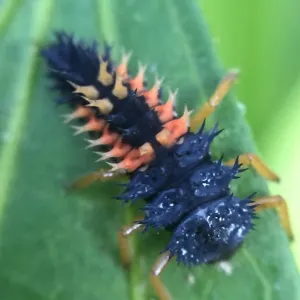Blog by Paula Pashby
When folks learn that I am a Master Gardener, I am often asked a question or two about garden issues. The first one is frequently a “what is it” question, and the second is generally about a “friend or foe” concern about insects. I usually respond with a “let me get back to you” so that I can take some time to find the best answer.
My sister, who lives in Southern Oregon, recently reached out with a question that fell into the second category… “Should I be concerned about this little creature?” She sent me a photo of a long-legged spider. I already know that, in general, spiders are good to have in the garden, but are they dangerous?

It turns out that the spider is indeed a good friend to have in the garden. Plus, it is safe for pets and gloveless hands. Her “friend” turned out to be the Filmy Dome Spider, Neriene radiata. The Filmy Dome Spider is known as a woodland spider, commonly found in North America, Europe, and Asia. These spiders often live among plants that are close to the ground. They are beneficial because they prey on mosquitoes and gnats. If you see them in your garden, do take good care of them!
I enjoy these kinds of questions since they frequently lead to the fun discovery of something new about the garden ecosystem. The pleasure from learning something new and satisfying an itching curiosity about the garden is the real reason why I joined the UC Master Gardener Solano County program.
When I first started, I did not realize the extent and depth of importance that insects have for our garden. The “California Master Gardener Handbook” gave me my first glimpse into the wonderful world of insects, and, to my surprise, this sparked a deeper curiosity about the creatures in my garden. I also started to notice small movements in and between the plants, with lots of crawling or buzzing about in my garden.
The Master Gardener classes taught me to take time to just observe the insects in the garden. I also learned how to better identify the types of insects and how each may affect the garden in different ways. I was also reminded about the old adage, “do not judge a book by its cover,” even though some of these bugs do appear to be scary and menacing.
One example that really hit home was when I found a miniature dragon-like monster on a plant. With alarm, I then started to notice that my garden was full of these little fiends. My impulse was to seek out a pesticide… this was during my dark age of ignorance! My new Master Gardener investigative skills allowed me to determine that, despite the creepy looks, this insect was a ladybug larva. Furthermore, mature ladybugs can eat up to 50 aphids per day, which is estimated to be about 5,000 aphids during their lifetime! Without a doubt, they are a good “friend” of the garden.

Lessons learned and many more that followed! I am a happy and enlightened member of the UC Master Gardener Solano County program.

